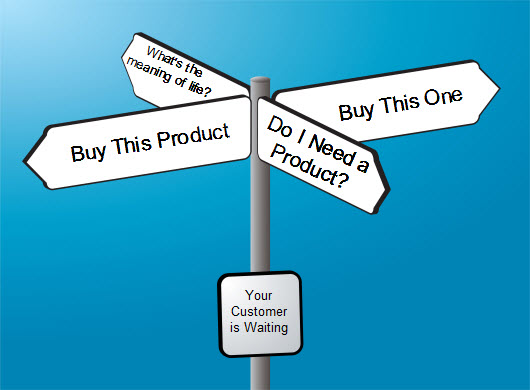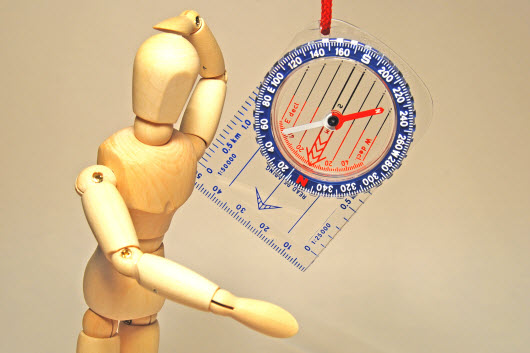Can You Really Make a Sale No Matter Who Your Customer is?
 There are five basic stages of decision making when people go onto the web looking for information about a product. In each of these cases, the potential customer has a different level of awareness about your products and will require a different kind of sale. Here’s how to sell to each level of decision making as well as how to make sure that your squeeze page will resonate with all kinds of clients:
There are five basic stages of decision making when people go onto the web looking for information about a product. In each of these cases, the potential customer has a different level of awareness about your products and will require a different kind of sale. Here’s how to sell to each level of decision making as well as how to make sure that your squeeze page will resonate with all kinds of clients:
The One Who Doesn’t Know He Needs Your Product
These are the hardest to sell because they probably just stumbled over your website completely by accident and have no idea what your product is or why they should buy the thing. For these kinds of people, a soft sell is often the best approach since you want to sell them first on the problem and then sell them on the solution to the problem.
This is kind of like the iPad when it first came out. Many people assumed it would be a flop simply because it was a solution in search of a problem. However, Apple did a smart thing — they demonstrated the problems that could be solved with their new tablet computer and lo and behold, millions of people started to buy it. Now it helps that they already had the Apple cache, however, even if they didn’t have it, they could have done this by simply demonstrating the problem they solve.
How to Sell to Them
 Very simple really — show them that they have a problem. If for example your product was a robot vacuum cleaner, then you need to show them how much time and effort is wasted on using a manual vacuum to do the chore. Make the problem into their problem and they’ll be looking for a solution.
Very simple really — show them that they have a problem. If for example your product was a robot vacuum cleaner, then you need to show them how much time and effort is wasted on using a manual vacuum to do the chore. Make the problem into their problem and they’ll be looking for a solution.
The One Who Knows He Needs a Solution
The second kind of customer has already identified a problem but has not necessarily figured out that there is a solution to the problem. So, using our robot vacuum cleaner example, they may be aware that they need a better way to clean their carpets but not that there is a solution which doesn’t involve hiring a maid.
How to Sell to Them
You need to demonstrate your solution and show that it can take care of everything they need. This may mean for example anticipating their questions and answering them before they have a chance to ask them (i.e. will the robot vacuum cleaner be able to go up and down stairs?).
The One Who Knows He Needs a Product (But Not Necessarily Yours)
The third kind of customer knows there are solutions to the problem they need to solve and they know that there are products out there which can solve the problem. However, they don’t necessarily know that your product can solve the problem for them.
So, using our example of the robot vacuum cleaner, they already know that they need to find a better way of getting the chore of cleaning the house done. Perhaps they are too busy to do the job themselves or they have a bad back. They’re not sure however what the best method is to solve the problem.
In this case, you need to show them that your product is the one they have been searching for to solve the problem they are facing. You should show them that your product has all the features they’ll need in order to solve the problem that they want to solve. Give them the confidence that you have the right solution to their problems.
How to Sell to Them
Here, your goal is to show your potential customers exactly why your product does solve the problem that they have. If they want for example to find a way to get their carpeting cleaned up every day, then you need to show them that your product can accomplish exactly that for them and do it with ease. Show them the features and how it can solve the problem and they’ll be ready to buy from you.
The One Who Is Weighing His Options

The next kind of prospect is generally the sort of person who is weighing his options. He know what you have to offer but isn’t 100% sold on whatever it is that you have for sale. For this kind of prospect, a different approach entirely is required. You need to show them not only that your product does the job but also why it does the job better than anyone else’s product does the job.
In this case, features become very important because you need to be able to show people how to compare between your product and leading competing products. So for example, if your robot vacuum cleaner is capable of going down stairs then you need to highlight that fact as compared with your competitor’s product which merely uses an electronic wall to prevent the thing from falling down the stairs.
How to Sell to Them
In this case, it really comes down to doing a better job of making your case than your competitor. Your copy needs to be personable and it needs to really show your potential clients why they really will benefit by using your product as opposed to someone else’s product. The example I like to give is that of the iPod — it was not the first MP3 player on the market by any stretch of the imagination. However, Apple was able to capture the market because they offered customers a reason to choose their product over that of a rival.
The Customer Who Has Made a Decision
This is likely the easiest customer of all to sell a product to. This kind of customer already knows they want a specific product and a specific model of a specific product. They aren’t looking for you to sell them on why your product is the best. They only want to know where they can get the best overall deal on the product that they plan on purchasing.
Now, if you happen to be an exclusive direct seller of a particular product, then that’s perfectly fine — you will then be offering the best deal possible on your particular product. However, if you are an affiliate or a reseller, then you need to show the customer why your deal is better than someone else’s deal on the same product.
How to Sell to Them
In essence, here it comes down to price and deals. So for example, you may offer extra bonuses to customers who make a purchase through your web link for an affiliate product. Or you may offer free shipping on a physical product. You could also offer free tech support or a liberal returns policy. The key here is to find something which makes you unique and gives your potential customer a reason to make a purchase from you as opposed to your competitors who sell the same product.
Selling to All of Them
Okay, so now that we know what the five basic kinds of customers are, we have a brand new problem. We need to know how to sell to each of these kinds of customers. There are two ways to accomplish this; one of them a bit slicker than the other though neither one is 100% foolproof.
The Problem
The problem here is that different customers will need different pieces of information and different kinds of pitches to make them interested in purchasing whatever product you happen to be selling to them. There are fortunately two basic ways to handle this problem. Neither one is 100% fool proof, but both should work adequately well to provide you with some good ideas:
The Technology Solution
I call this the technology solution because it uses more of a high tech way of doing things. In essence, the idea is to display different kinds of content to different visitors depending on how they arrive at your website.
So for example, someone who arrives with an incoming keyword of say “daily vacuuming” might get the first kind of pitch since they may not even know that there is a problem for them to have solved. Someone who shows up with a slightly more specific keyword (robot vacuum cleaner) could be shown a pitch which tells them about the benefits of your specific product.
Finally, those showing up with very specific keyword searches or who show up from a direct input of your keyword could be offered a pitch where you make your case for why you have the best deal going.
Your webmaster should be able to set up each of these kinds of squeeze pages for you based on a variety of different criteria. The trouble is of course that it’s not fool proof since you can’t possibly know with 100% certainty what kind of a customer showed up based on which keyword.
However, you can generally make a decent guess and this is often enough to route most customers to the right page. You can also include a “need more information?” button which will redirect those who do need more information than appears on the page they arrived at.
The Low Tech Method
The low tech method basically suggests creating a rather long squeeze page which runs through the progression of different types of clients and allows them to skim through it to find what they need to know.
This is based on the theory that those who want more detail will start at the top and work their way down while those who are ready to buy will likely scroll to the bottom to see the price and benefits you offer. It is of course not ideal since some customers may be confused or turned off when they see a long sales page, however, most people do know to keep scrolling to find what they want to know.
Bottom Line
You need to be prepared to sell to all kinds of customers. Then and only then will you be able to finally get the maximum number of sales possible. So go and try these ideas and see what works for you. Then, come back and tell us about your experiences. We’d love to hear about them.

